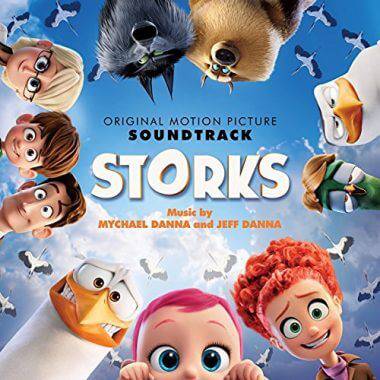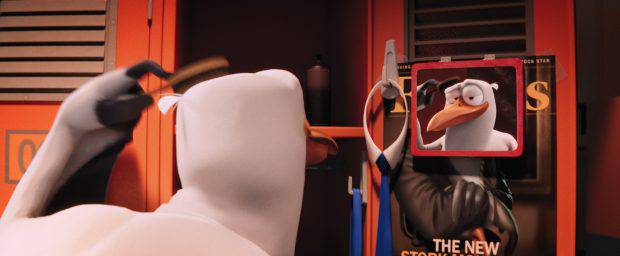An Interview with ‘Storks’ Composers Jeff and Mychael Danna
Jeff Danna and Mychael Danna – the composing team that brought us The Good Dinosaur soundtrack now bring us the music for Warner Bros and Sony Pictures Imageworks’ latest animation feature, Storks.
 The Danna brothers have an extensive repertoire of film scoring experience, from gritty thrillers and live action horrors to uplifting feel-good adventures and animated comedies. Throughout their careers they have won numerous awards for their music in films including Resident Evil: Apocalypse, The Imaginarium of Doctor Parnassus, Moneyball and The Good Dinosaur. They have also received countless nominations for their achievements in music and in 2013, Mychael won an Oscar for ‘Best Achievement in Music Written For Motion Pictures’ for his Life of Pi original score. Recently, they have been working together on the score for TV series Tyrant, for which they have already received Primetime Emmy nominations.
The Danna brothers have an extensive repertoire of film scoring experience, from gritty thrillers and live action horrors to uplifting feel-good adventures and animated comedies. Throughout their careers they have won numerous awards for their music in films including Resident Evil: Apocalypse, The Imaginarium of Doctor Parnassus, Moneyball and The Good Dinosaur. They have also received countless nominations for their achievements in music and in 2013, Mychael won an Oscar for ‘Best Achievement in Music Written For Motion Pictures’ for his Life of Pi original score. Recently, they have been working together on the score for TV series Tyrant, for which they have already received Primetime Emmy nominations.
Before collaborating on animation features in recent years, Mychael wrote the music for Sony Pictures Animation’s Surf’s Up (2007) and Jeff scored the soundtrack to DisneyToon Studios’ Disney Princess Enchanted Tales: Follow Your Dreams (2007).
We were able to catch up with Mychael Danna [MD] and Jeff Danna [JD] and they were happy to talk about scoring their latest animated feature film Storks…
 Throughout the Storks film, the soundtrack takes on a variety of themes; pinpointing each chapter as the plot develops. For instance, the ‘Baby Factory’ scene features music with a rhythmic quality and repeated phrasing which clearly describes a machine-like production line environment – at the same time as simultaneously punctuating the action on screen. Similarly, the hilarious ‘Wolf Pack’ scenes were accompanied by Big Band music infused with Latin jazz, which describes the animation of the wolves perfectly. There must have been great communication between yourselves and the directors. What was this relationship like and was there any collaboration and overlap between your fields?
Throughout the Storks film, the soundtrack takes on a variety of themes; pinpointing each chapter as the plot develops. For instance, the ‘Baby Factory’ scene features music with a rhythmic quality and repeated phrasing which clearly describes a machine-like production line environment – at the same time as simultaneously punctuating the action on screen. Similarly, the hilarious ‘Wolf Pack’ scenes were accompanied by Big Band music infused with Latin jazz, which describes the animation of the wolves perfectly. There must have been great communication between yourselves and the directors. What was this relationship like and was there any collaboration and overlap between your fields?
JD: Everything we do on a film like Storks is a collaborative process with the Creative Team. In the case of Storks, we had a small and (happily) consistent group of 4 of the film makers that we liaised with for all of the musical decisions. We would write our first drafts and present them to the team, and then the 6 of us would discuss the merits (or lack thereof!) of each section of each cue. Then the next week we could come back with version 2. This went on for months as we worked our way through the individual concepts and scenes of the film. Often we would be guided by the writer and director explaining exactly what each character and each scene was aiming to achieve for the effectiveness of the overall film. Our team on Storks were particularly excellent at being clear with their feedback, and striving with us for a score that was tuneful , funny and dramatic.
When watching any film I always find myself listening intently to the incidental music; often paying more attention to the score than the visuals and dialogue. When I watched Storks I attentively listened to the soundtrack; but very often I found myself absorbed by the film and simply enjoying the animation and music – as one is supposed to do! I noticed that the soundtrack often consisted of three distinct layers (although many more in places for texture), plentiful variation and a momentum that propels the story and glues all the visual shots together. How did you craft such complexity in your soundtrack without overpowering the visuals?
JD: Well we love it when folks like you really notice the details! The thing about Storks is that many of the sections are visually HUGE. The baby machine, the wolf pack chase. These are not subtle moments, so there was a need for the score to match the power of the visuals and these muscular scenes in the film. Conversely , we consciously dialed things back for the all-important ‘ emotional moments’ : Tulip at the campfire , Tulip on the ship , or Nate with the Gardner Family…..but these smaller moments were not only properly scaled for those intimate scenes , they also provided a contrast to make the Big Scenes seem Bigger and More Complex when we really needed it.
The soundtrack encompasses a wide variety of musical styles and yet maintains a quirkiness throughout that gives it charm and sparks interest to the listener. I couldn’t help but notice a correlation between the melodic quality of the Storks soundtrack and the background music of classic Looney Tunes episodes; essentially, it appeared that your music was paying homage to the history of Warner Bros animation. Was this intentional? If so, how did you achieve this?
MD: You absolutely picked up on what we were inspired by, yes. The score was in fact recorded on the same WB stage where those legendary animation scores were recorded 60 and more years ago. We even found an old picture of Carl Stalling recording there, on the same stage with a group of musicians…. which inspired us to wear suits during the sessions in homage to him! Being part of the lineage of WB was something we took very seriously, with the feeling that Storks is definitely part of that bloodline in its animation style and in its very successful grown up humour that is still family friendly. to do this we kept the score very nimble, able to shift quickly between styles and moods. lots of fast fast notes, and then heartfelt melodies. Unusual percussion instruments also help to keep it a more modern take on the classic WB animation sound.
You both have a wealth of experience composing for live action films and more recently you have been composing for animated features. Does animated film impose more challenges or greater flexibility when writing music?
MD: Animated films have a different process than live action which in some ways is easier for the composers. in animation it’s almost like a radio play in that the voice actors record the screenplay early on a year or more before the final music scoring, so the structure of the story and beats are quite locked early on. as the scenes get animated it obviously brings it visually to life, but the emotional content and story arc haven’t really changed. in live action of course a big part of the post production schedule is editing, in other words changing the sequence and rhythm of the story episodes and beats. Something that the composers must chase and keep up with as well as writing a score. Much more difficult.
There are many student animators that read our articles here at Skwigly. A challenge that many students may find is knowing how to go about working with a music composer. What advice would you give them?
MD: Come up with a concept together… spend time carefully figuring out what the role of the music is in the storytelling. but then: extend trust to the composer…. like an animator he starts with sketches, rough boards, all of which as very far from the final score as the story boards are from final animated and lit scenes. as well, temp scores are a very dangerous (if necessary) crutch…. don’t let those choices dictate the musical choices of your composer, be open to their greater sensitivity and experience, and let go of that temp!
 Storks hits UK cinemas today, Friday 14th October. For more on the film you can read our review and visit the official site at storksmovie.com
Storks hits UK cinemas today, Friday 14th October. For more on the film you can read our review and visit the official site at storksmovie.com

